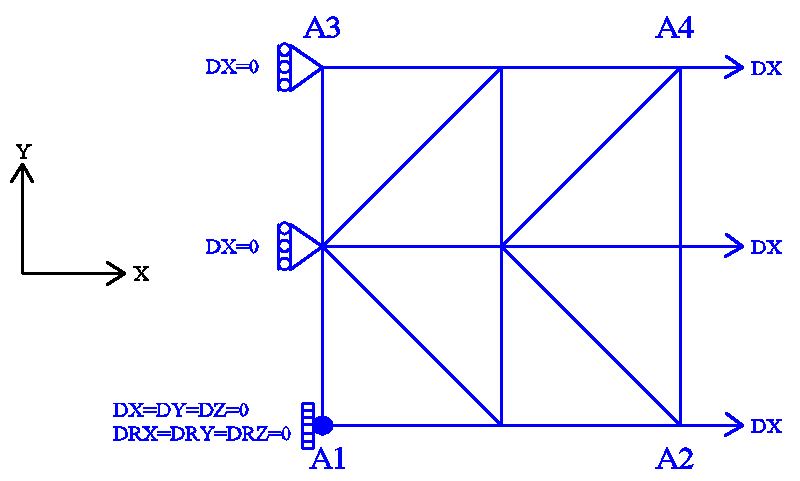17. O modeling#
17.1. Characteristics of modeling#
In this modeling, it is verified that the two thermal expansion loads (homogeneous temperature in the thickness and constant temperature gradient in the thickness) lead to the same state of stress as two equivalent simple mechanical loads: extension along \(\mathrm{Ox}\) and bending around \(\mathrm{Oy}\).
Note: This check is valid regardless of the behavioral relationship.
\(\mathrm{A6}\)

Figure 17.1-a: mesh and boundary conditions.
Modeling: DKTG
Behavioral relationships: GLRC_DM, GLRC_DAMAGE, DHRC, ELAS
Boundary conditions:
Embedding in \({A}_{1}\);
\(\mathit{DX}=0.0\) on the \({A}_{1}-{A}_{3}\) edge;
\(\mathit{DRY}=0.0\) on the \({A}_{1}-{A}_{3}\) ridge
Load 1 (extension):
The reference calculation is done with the following mechanical load:
\(\mathrm{DX}={2.10}^{-4}m\) on the \({A}_{2}-{A}_{4}\) ridge
The equivalent thermomechanical load is:
\(\mathit{DX}=0.0\) on the \({A}_{2}-{A}_{4}\) ridge
Reference temperature: \(+10°C\)
Homogeneous temperature imposed: \(-10°C\)
Thermal expansion coefficient: \(\alpha ={1.10}^{-5}/°C\)
Loading 2 (bending):
The reference calculation is done with the following mechanical load:
\(\mathrm{DRY}={6.10}^{-3}m\) on the \({A}_{2}-{A}_{4}\) ridge
The equivalent thermomechanical load is:
\(\mathit{DRY}=0.0\) on the \({A}_{2}-{A}_{4}\) ridge
Reference temperature: \(+10°C\),
Homogeneous temperature gradient imposed: \({T}_{\mathrm{inf}}=+40°C,{T}_{\mathrm{mil}}=+10°C,{T}_{\text{sup}}=-20°C\),
Thermal expansion coefficient: \(\alpha ={1.10}^{-5}/°C\),
Reminder: the thickness of the shell is \(0.1m\).
17.2. Characteristics of the mesh#
Number of knots: 9. Number of stitches: 8 TRIA3; 8 SEG2.
17.3. Tested values and results for load 1#
For equivalent mechanical and thermal loads, it is verified that the force (homogeneous in the plate) is the same. The significant component here is NXX.
The results are very good. Thermomechanical loads give the same results as equivalent mechanical loads for all behavioral relationships (the error is less than \({1.10}^{-7}\)).
17.4. Tested values and results for loading 2#
For equivalent mechanical and thermal loads, it is verified that the force (homogeneous in the plate) is the same. The significant component here is MXX.
The results are very good. Thermomechanical loads give the same results as equivalent mechanical loads for all behavioral relationships (the error is less than \({1.10}^{-7}\)).